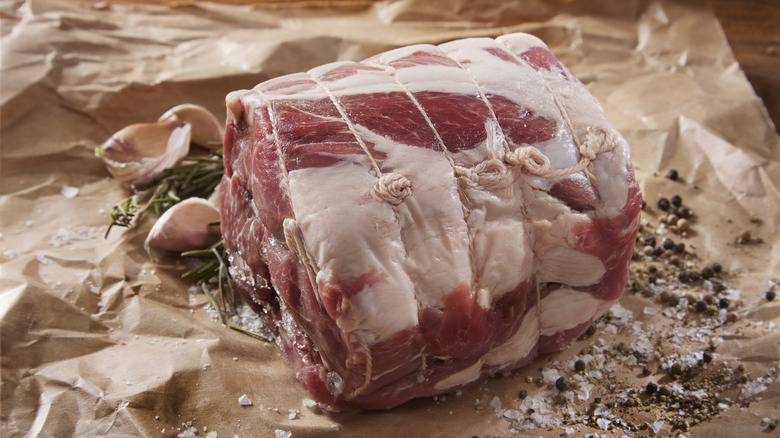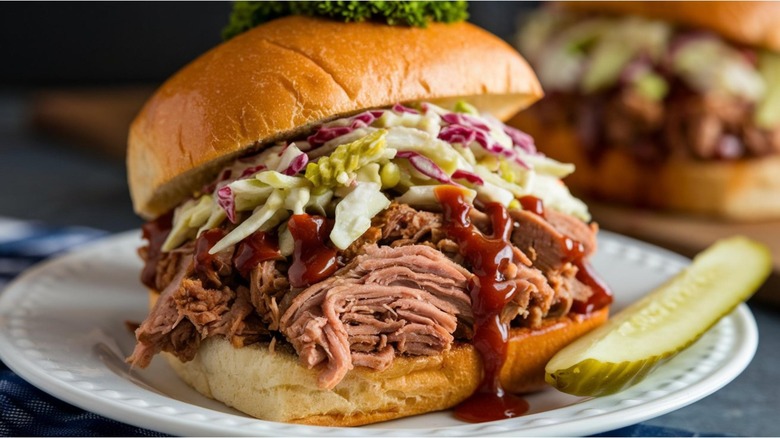Why Temperature Matters More Than Ever When Cooking Tough Cuts Of Pork
Pork is perhaps the most versatile meat, as each of its cuts is very distinct. Pork belly becomes bacon and chicharron, pork leg becomes ham, pork loins become pork chops, and pork shoulder becomes carnitas, pork roast, pozole, pernil, and pulled pork. Each cut has its own unique traits, and consequently, they all favor different cooking methods. The toughest cuts of pork are the most challenging to work with, as they contain dense muscle fibers and lots of gristly connective tissue. WIth the right technique however, tough cuts can be turned into the tenderest, juiciest pork you'll ever eat. The trick is all in the cooking temperature.
If you look up the right cooking temperature for pork, you'll find a guide from the U.S. Department of Agriculture breaking down the safety implications of cooking temperatures in pork. Pork is particularly notorious for spreading foodborne illnesses; well-done pork chops are a relic of past concerns about outbreaks. Today, the USDA recommends cooking pork to 145 degrees Fahrenheit to eliminate all potential pathogens. That's fine for a tender cut, like when you are grilling pork chops, but for tough cuts of pork, you actually want to break this rule. Tough cuts should be cooked to a temperature between 170 and 210 degrees. You would think this leaves you with overcooked meat, but it's actually the secret to eliminating the toughest parts of pork.
How temperature affects tenderness in pork
To understand the role that temperature plays in making pork more tender, you need to understand what makes tough cuts of pork so challenging in the first place. The toughest cuts are found around the shoulder and leg regions, which makes sense, because those are the muscles that get the most use. As a general rule with all types of meat, the more a muscle is involved in an animal's movements, the tougher a cut with that muscle will be. These parts of the pig are also packed with connective tissue, which is too tough to even chew through. These connective tissues are primarily composed of a protein called collagen, which undergoes an almost magical transformation when you cook it to the right temperature.
At approximately 160 degrees Fahrenheit, collagen begins to gelatinize, which makes the pork incredibly juicy and tender. That's why the USDA-recommended cooking temp of 145 degrees is no good for tough cuts. It takes more than temperature to turn collagen into gelatin; it also takes time. For this reason, tough cuts need to be cooked low and slow, at temperatures no higher than 275 degrees. This will allow the pork to slowly come up to temperature, with plenty of time for collagen to break down, instead of heating up really fast and getting overcooked. With that in mind, it's time to break down what these tough cuts are, and what you can make with them.
The toughest cuts of pork (and how to cook each)
The toughest cuts of pork you need to know about are pork shoulder and pork butt. Both cuts come from the top of the pig's front legs. The pork butt comprises the upper shoulder and a portion of the neck muscles, while the shoulder comes from just below, right up to the pig's leg. These muscles are packed with fat and connective tissue. Nevertheless, they are two of the most popular cuts of pork, especially the butt, because it is so incredibly versatile. One of the best things to make with pork butt is pulled pork, which should be cooked to 200 degrees Fahrenheit for the ultimate juicy and tender meat. The traditional cooking method for pulled pork entails smoking it for hours at a low temperature, but if you don't have a smoker, you can use an oven or slow-cooker in a pinch.
Another tough cut of pork that you should know about is pork shank. Pork shanks are the front legs of the pig, a cut found directly beneath the pork shoulder. They have a bone right in the middle, which makes the cooking temperature even more important. Low-and-slow cooking allows the bone marrow to soften along with the connective tissue. Pork shanks are especially good for braising. Mastering a crock pot is the best way to ensure tender braises, and can help you make the most of any tough cut.


